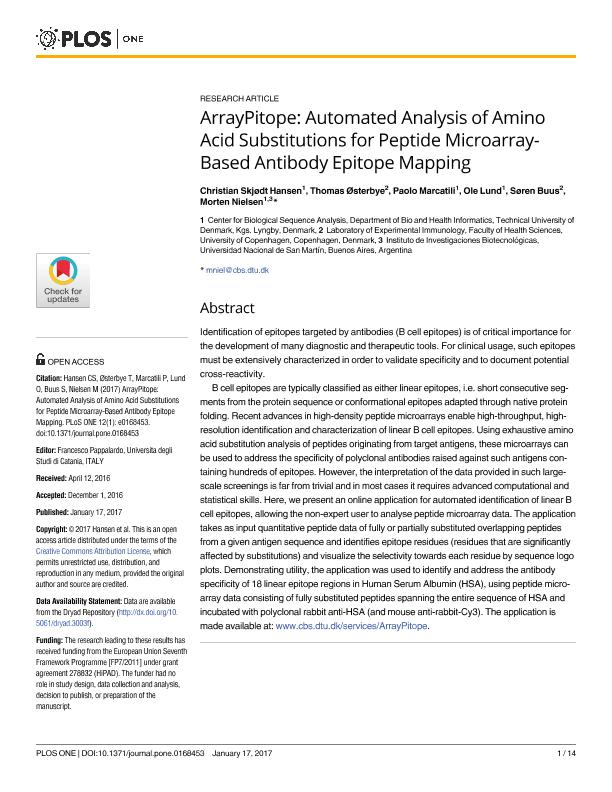Mostrar el registro sencillo del ítem
dc.contributor.author
Hansen, Christian Skjødt
dc.contributor.author
Østerbye, Thomas
dc.contributor.author
Marcatili, Paolo
dc.contributor.author
Lund, Ole

dc.contributor.author
Buus, Søren

dc.contributor.author
Nielsen, Morten

dc.date.available
2018-06-14T14:48:40Z
dc.date.issued
2017-01
dc.identifier.citation
Hansen, Christian Skjødt; Østerbye, Thomas; Marcatili, Paolo; Lund, Ole; Buus, Søren; et al.; ArrayPitope: Automated analysis of amino acid substitutions for peptide microarray-based antibody epitope mapping; Public Library of Science; Plos One; 12; 1; 1-2017
dc.identifier.issn
1932-6203
dc.identifier.uri
http://hdl.handle.net/11336/48623
dc.description.abstract
Identification of epitopes targeted by antibodies (B cell epitopes) is of critical importance for the development of many diagnostic and therapeutic tools. For clinical usage, such epitopes must be extensively characterized in order to validate specificity and to document potential cross-reactivity. B cell epitopes are typically classified as either linear epitopes, i.e. short consecutive segments from the protein sequence or conformational epitopes adapted through native protein folding. Recent advances in high-density peptide microarrays enable high-throughput, highresolution identification and characterization of linear B cell epitopes. Using exhaustive amino acid substitution analysis of peptides originating from target antigens, these microarrays can be used to address the specificity of polyclonal antibodies raised against such antigens containing hundreds of epitopes. However, the interpretation of the data provided in such largescale screenings is far from trivial and in most cases it requires advanced computational and statistical skills. Here, we present an online application for automated identification of linear B cell epitopes, allowing the non-expert user to analyse peptide microarray data. The application takes as input quantitative peptide data of fully or partially substituted overlapping peptides from a given antigen sequence and identifies epitope residues (residues that are significantly affected by substitutions) and visualize the selectivity towards each residue by sequence logo plots. Demonstrating utility, the application was used to identify and address the antibody specificity of 18 linear epitope regions in Human Serum Albumin (HSA), using peptide microarray data consisting of fully substituted peptides spanning the entire sequence of HSA and incubated with polyclonal rabbit anti-HSA (and mouse anti-rabbit-Cy3). The application is made available at: www.cbs.dtu.dk/services/ArrayPitope.
dc.format
application/pdf
dc.language.iso
eng
dc.publisher
Public Library of Science

dc.rights
info:eu-repo/semantics/openAccess
dc.rights.uri
https://creativecommons.org/licenses/by-nc-sa/2.5/ar/
dc.subject
Antibody
dc.subject
Peptide Array
dc.subject
Motif
dc.subject.classification
Salud Ocupacional

dc.subject.classification
Ciencias de la Salud

dc.subject.classification
CIENCIAS MÉDICAS Y DE LA SALUD

dc.title
ArrayPitope: Automated analysis of amino acid substitutions for peptide microarray-based antibody epitope mapping
dc.type
info:eu-repo/semantics/article
dc.type
info:ar-repo/semantics/artículo
dc.type
info:eu-repo/semantics/publishedVersion
dc.date.updated
2018-06-13T14:58:15Z
dc.journal.volume
12
dc.journal.number
1
dc.journal.pais
Estados Unidos

dc.journal.ciudad
San Francisco
dc.description.fil
Fil: Hansen, Christian Skjødt. Technical University of Denmark; Dinamarca
dc.description.fil
Fil: Østerbye, Thomas. Universidad de Copenhagen; Dinamarca
dc.description.fil
Fil: Marcatili, Paolo. Technical University of Denmark; Dinamarca
dc.description.fil
Fil: Lund, Ole. Technical University of Denmark; Dinamarca
dc.description.fil
Fil: Buus, Søren. Universidad de Copenhagen; Dinamarca
dc.description.fil
Fil: Nielsen, Morten. Consejo Nacional de Investigaciones Científicas y Técnicas. Centro Científico Tecnológico Conicet - La Plata. Instituto de Investigaciones Biotecnológicas. Universidad Nacional de San Martín. Instituto de Investigaciones Biotecnológicas; Argentina
dc.journal.title
Plos One

dc.relation.alternativeid
info:eu-repo/semantics/altIdentifier/doi/https://dx.doi.org/10.1371/journal.pone.0168453
dc.relation.alternativeid
info:eu-repo/semantics/altIdentifier/url/http://journals.plos.org/plosone/article?id=10.1371/journal.pone.0168453
Archivos asociados
